THE FRENCH
Page 42

Page 44

Page 45
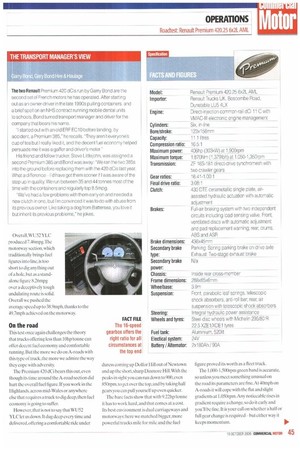
Page 46
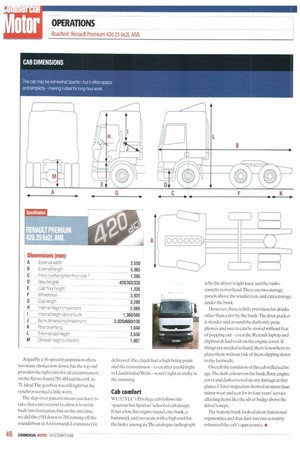
Page 47
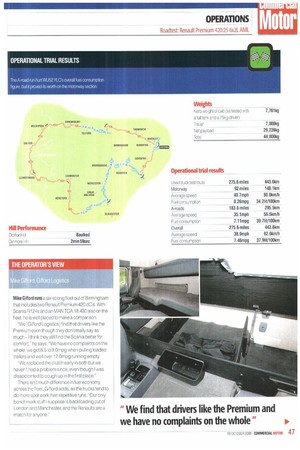
Page 48
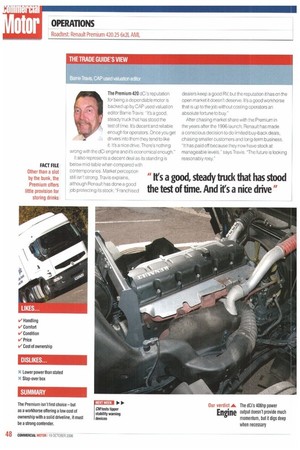
Page 49

Page 51

Page 52
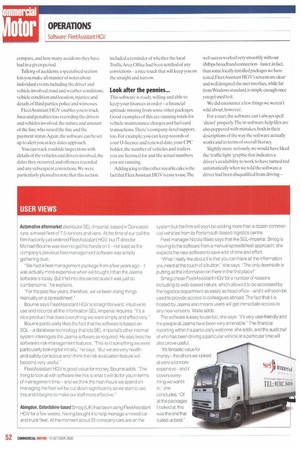
Page 53
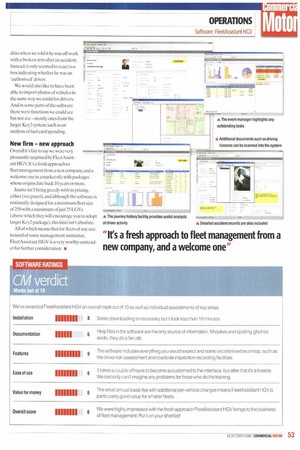
If you've noticed an error in this article please click here to report it so we can fix it.
REVOLUTION
A decade on from its introduction, the Premium remains the ultimate barometer of Renaults success in the UK. With late-year, low-mileage Euro-3 tractors thin on the ground,
could this truck be the right business decision for you? years ago Renault's new-look tractor, the Premium,sparked a revolution in the -UK that would boost the French share
of the market into double figures. Before 1996 the French possessed around 2% of the tractor market as they battled the Swedes, Germans, Italians— and,of course, the Brits (remember EREFoden and Seddon Atkinson?).
The move to replace two thirds of its heavy truck range with the Premium, combined with renewed sales and marketing vigour, turned heads and opened chequebooks.The company picked up major volume customers and Premiums were seen coast to coast.
By the end of 2001 Renault had sold 1,940 two and three-axle tractors in Britain. increasing its market share to 11 %.
This was achieved with a refined and sleek exterior and a Spartan cab that offered space and simplicity — ideal for long-haul work — with a competitive front-end price backed up by buy-hack options.
The first engines were a 9.8-litre lump rated at 300 and 340hp, and an 11.1-litre at 370 and 385hp.The latter was phenomenally successful,delivering the kind of fuel economy operators loved at 38,40 and 41 tonnes.This was complemented in 1999 by a 400hp option just prior to the arrival of Renault's most important engine, the dCi. The dCi 11 shared the bore and stroke
of the 11.1-litre unit but was a new design which proved lobe superior. Four valves per cylinder, a reinforced block and articulated pistons were the main hardware changes, hut the major innovation proved to he a move to common-rail injection: the French proclaimed it as the first appearance of this technology on any heavy-duty truck engine. The dCi II started life at Euro-2 but went on to meet Euro-3.There were other changes too: out went Renault's own B18 gearboxes in favour of ZF 16-speeders with a cableoperated shift mechanism which enabled the ZF Servoshift air-operated shift-assistance system to be added.This enhanced the gear change with a shorter throw between gears. The ZF Intarder, an integral hydraulic retarder providing up to 500kW of braking power, became an option, complete with a 130kg weight penalty
The four-valve head and centrally mounted injection improved breathing and brought an increase in output, uprating the engine to 406hp with 1,870Nm of torque delivered at a plateau between 1,050 and 1,350rpm. That might appear a little on the light side compared with today's torque-based engines, but it produced a flexible truck that wasn't afraid of a fight. However. operators with 11.1-litre lumps at Euro-2, arguably the most fuel-efficient emission level, noticed a drop in
fuel economy when they moved to the Euro-3 model,This was felt across the board by all the truck manufacturers and it meant operators started to compare and contrast products more industriously, which aided French market share.
Product profile
WL152 YLC is of Somerset stock, pulling fridges and the like out of Bridgwater for Langdons. Since its registration in late November 2002, it had clocked 457,388km prior to setting off from Hinckley on CM's used truck test route:That equates to around 114.000km a year (or 2,200km each week)
since it was plated — as close to CAP average for a fleet truck as you'll find.
This Premium 420 dCi tractor is run of the mill in terms of specification. It's a 6x2, powered by Renault's 11.1-litre,six-cylinder, charge-cooled DI diesel with V-MAC III electronic engine management. It produces 406hp (303kW) at 1,900rpm with peak torque of 1,870Nm (1,3791bft) at 1,050-1,350rpm.
The gearbox is a synchromesh ZF di rectdrive 16-speed unit with ZFServoShift and an exhaust brake that requires around 2,0002,40Orpm to be really effective.The cab is fitted with a bottom bunk and a hammock-type top bunk that pulls out from the wall.
So what does Renault want for it?The asking price is &.i8.995 (ex-VAT), and in case you were wondering what CAP Used Valuations might have thought. its price is identical. 'Ibis vehicle is just a tad too old to qualify for the 12-month repair and maintenance deal currently available on stock up to 31/2 years old, but you can take advantage of a 0.99% finance deal. IL is currently on the free stock list at Dunstable, so if you are interested in this motor contact Renault and ask for Chris Sharp
referring to WI.J52 YLC — though it might have been sold by the time you read this.
Productivity
The truck was fully freighted to 44 tonnes giving a 29.2-tonne payload with our 7.0-tonne curtain-sided trailer: the unit weighed in at 7,761kg with a full tank and the usual 75kg for the driver. We started and finished the two-day tour in the rain, but from Tamworth to the M69
on the return to Hinckley the following day we had sunshine and stiff westerly winds with tern peratures around 18C. Traffic was post-holiday season, so noTupperware boxes on wheels towed by cars or 4x4s struggling along at 35mph. and we missed the school runs on both days.The tough Aroad section was ground out with 7.11mpg, a decent figure considering we were running at 44 tonnes
—and is over the 7.00mpg cut-off point which defines vehicles that seem to struggle. An average speed of 35.1mph through here tells its own tale.
The power output of 406hp (lower than the brochure's 420hp or the listed 412hp) doesn't lead to a lot of momentum.To gain a top fuel return you need to be pushing 7.5mpg on the Aroad section, but that's a difficult figure to reach even when things are going your way. Overall,WL:52 YLC produced 7.46mpg.'llie motorway section, which traditionally brings fuel figures into line, is too short to dig anything out of a hole, but as a standalone figure 8.26mpg over a deceptively tough undulating route is solid. Overall we pushed the
average speed up to 38.9mph, thanks to the 49.7mph achieved on the motorway.
THE TRANSPORT MANAGER'S VIEW
Garry Bond, Gary Bond Hire & Haulage
The two Renault Premium 420 dCis run by Garry Bond are the second set of French motors he has operated. After starting out as an owner-driver in the late 1990s pulling containers, and a brief spell on an NHS contract running mobile dental units to schools, Bond turned transport manager and driver for the company that bears his name.
"I started out with an old ERF EC10 before landing, by accident, a Premium 385," he recalls. "They aren't everyone's cup of tea but I really liked it, and the decent fuel economy helped persuade me it was a gaffer and driver's motor."
His friend and fellow trucker, Steve Littlejohn, was assigned a second Premium 385 and Bond was away: We ran the two 385s into the ground before replacing them with the 420 dCis last year. What a difference I'd have got them sooner if I was aware of the step up in quality. We run between 35 and 44 tonnes most of the time with the containers and regularly top 8.5mpg.
"We've had a few problems with them early on and needed a new clutch in one, but I'm convinced it was to do with abuse from its previous owner. Like taking a dog from Battersea, you love it but inherit its previous problems," he jokes.
On the road
This test once again challenges the theory that trucks offering less than 10hp/tonne can offer decent fuel economy and comfortable running. But the more we do on A-roads with this type of truck, the more we admire the way they cope with adversity.
'The Premium 420 dCi bears this out, even though its time around the A-road section did hurt the overall fuel figure. If you work in the highlands, across mid-Wales or anywhere else that requires a truck to dig deep, then fuel economy is going to suffer. However, that is not to say that WI.J52 YLC let us down. It dug deep every time and delivered,offering a comfortable ride under
duress coming up Dolfor Hill out of Newtown and up the short,sharp Dinmore Hill.With the peaks in sight you can run down to 900, even 850rpm, to get over the top, and by taking half gears you can pull yourself up even quicker. The bare facts show that with 9.22hp/tonne it has to work hard, and that comes at a cost. Its best environment is dual carriageways and motorways: here we matched bigger, more powerful trucks mile for mile and the fuel
figure proved its worth as a fleet truck.
The 1,000-1,500rpm green band is accurate, so unless you meet something unusual on the road its parameters are fine. At 40mph on A-roads it will cope with the flat and slight gradients at 1.05Orpm.Any noticeable rises in gradient require a change,so do it early and you'll be tine. It is your call on whether a half or full gear change is required but either way it keeps momentum.
Arguably a 16-speed transmission offers too many choices low down, hut the top end provides the right ratio for all circumstances; on the fiat we found 21-L4H and then 6L to 7L ideal.The gearbox was still tight but the synchros seemed a little worn. The slap-over pattern means you have to take that extra second to allow it to settle back into formation. but on the one time we did this (5H down to 3H coming off the roundabout at A44 towards Leominster) it
delivered.The clutch had a high biting point and the transmission even after a cold night in Llandrindod Wells wasn't tight or sticky in the morning.
Cab comfort
Vv1.152 YLC's Privilege cab follows the 'spacious but Spartan' school of cab design. It has a low, flat engine tunnel,one bunk, a hammock and two seats, with a high roof for the lanky among us.The analogue tachograph
is by the driver's right knee and the radiocassette is overhead.There are two storage panels above the windscreen, and extra storage under the bunk.
However, there is little provision for drinks other than a slot by the bunk.The door pocket is slender and around the dash only pens. phones and sweets can be stored without fear of popping out even the Renault laptop and clipboards had to sit on the engine cover. If things are needed to hand, there is nowhere to place them without risk of them slipping down to the footwells. Overall the condition of this cab reflected its age.The dark colours on the bunk, floor, engine cover and dash covered up any damage at first glance. Closer inspection showed no more than minor wear and tear for its four years' service affecting items like the silver badge above the driver's steps The bottom bunk looked clean; functional ergonomics and that dark interior certainly enhanced the cab's appearance. •
THE OPERATOR'S VIEW
Mike Gifford runs a six-strong fleet out of Birmingham that includes two Renault Premium 420 dOis. With Scania R124s and an MAN TGA 18.430 also on the fleet, he is well placed to make a comparison.
"We [Gifford Logistics] find that drivers like the Premium even though they don't really say as much — I think they still find the Scania better for comfort," he says. "We have no complaints on the whole, we get 8.5 to 9.0mpg when pulling loaded trailers and well over 12 Ompg running empty.
"We replaced the clutch early in both but we haven't had a problem since, even though I was disappointed to cough up in the first place."
There isn't much difference in fuel economy across the fleet, Gifford adds, as the trucks tend to do more spot work than repetitive runs. "Our only benchmark stuff I suppose is backloading out of London and Manchester, and the Renaults are a match for anyone."
THE TRADE GUIDE'S VIEW
The Premium 420 dCi's reputation for being a dependable motor is backed up by CAP used valuation editor Barrie Travis, "It's a good, steady truck that has stood the test of time. It's decent and reliable enough for operators. Once you get drivers into them they tend to like it. It's a nice drive. There's nothing
wrong with the dCi engine and it's economical enough." It also represents a decent deal as its standing is below mid-table when compared with contemporaries. Market perception still isn't strong. Travis explains, although Renault has done a good job protecting its stock: "Franchised
dealers keep a good RV, but the reputation it has on the open market it doesn't deserve, It's a good workhorse that is up to the job without costing operators an absolute fortune to buy."
After chasing market share with the Premium in the years after the 1996 launch, Renault has made a conscious decision to do limited buy-back deals, chasing smaller customers and long-term business. "It has paid oft because they now have stock at manageable levels," says Travis. "The future is looking reasonably rosy."
THE RENAULT DEALER'S VIEW
Dave Watts, Staffordshire CV
After six years as service dealer for Renault products, Staffordshire CV returned as a main dealer this year thanks to block exemption. Managing director Dave Watts says the company has believed in the Premium from the start: -it's been brilliant for us but it is an underestimated truck."
He believes the Premium 420 dCi was sold too competitively from new, making it a cheap product at the back end of its life: "People's perception of the Premium is lowered because they think it's a cheap truck. People are so besotted with the Scanias, Volvos and Dafs... if you measured out the cost of ownership, the Premium would be near the top of the pile.
If you can get drivers into them, they find they love it, With the finance packages available through Renault, it makes more sense to buy a Premium because you can make more money as an owner-driver with a Premium."
Watts cites an example— if you pay more for a like-for-like Scania, you borrow more from the bottom-line profit. It is, after all, a commercial business," he concludes.
OUR VIEW
has the final word
While the Premium might not be every drivers cup of tea, it's always worth remembering that road transport isn't a consumerled industry.
If you spend, it comes out of the bottom line—choose poorly and it could cost you your business.
Market perception has always been an issue with the Premium, perhaps in part due to its price against more 'prestige' motors, but get your drivers inside one and they'll be won over. When it comes to cost of ownership, it is low enough to be near the top of the pile.
If you are based up a mountain or down a valley, or if you have to tackle undulating motorway-free countryside at full GVW on a regular basis, perhaps you should look at something more powerful, if only to get there quicker—there is no guarantee it will be any more fuel efficient.
However, if you run around less challenging intercity motorway and dual carriageway routes across the UK, our trial results show WU52 YLC will work for you without letting you down. It offers workmanlike fuel economy, is comparatively cheap, has a clean service history and is ready to work. With the shortage of late-year, low-mileage vehicles compounding demand, WU52 YLC will not
be on the forecourt for long. HGV is such a new fleet management product that the ink has barely had time to dry on the packaging. Or at least that would be the case if it had any packaginghut as a web based product, this software's demands on the environment
laudably don't extend to that.
Brought to market by Jaama just a few weeks ago, it's a direct development of the firm's established FleetAssistant software (itself a cutdown version of the larger Key2 Vehicle Management package) that caters especially for HGVs,although it can handles other vehicles too. Cut down it may be, but there is still plenty to FleetAssistant HGV. Its content breaks down into two areas the bits you would expect in any fleet management package and the useful extras you'll be
pleasantly surprised by.
Who drives what and where
Included in the former group is an exhaustive driver database that enables you to keep records of who your drivers are, how long they've worked for you, the vehicles they can drive and their payroll particulars.You can also keep records of the vehicle they have been allocated and the journeys they have carried out, both private and business. You can keep a copy of their mugshots as
part of your records (if you need to remind yourself what they look like); there's also a section to record licence details and due dates for checks and renewals, as well as another that keeps track of any training courses you've sent them on. Vehicles are similarly well catered for, with
plenty of fields to enter chassis and engine numbers, acquisition details,odometer readings and finance information.And as the software isn't restricted to trucks you can include data on company cars, vans, trailers, tail-lifts, cranes and other plant. A diary function offers help in two key areas:
• Event manager enables you to enter due dates for vehicle-related events such as maintenance and servicing, safety inspections, or tacho and speed limiter checks. • Task manager lets you enter pretty much any task you'd care to,from phoning a supplier to carrying out a staff appraisal: again the system will notify you when the time comes,
HE BOTTOM LINE
Costs
• The basic cost for the hosted solution is 2250 per year. Per-vehicle charges apply on top.
For cars, vans, trailers and plant, the charges range from 21.33 per item per month for up to 25 vehicles to 33p per item per month for 150 vehicles or more. HGVs cost £3.50 per month. Training
• A day's training for up to 10 users at the user's premises is included in the cost; additional training is available from E175 per delegate per day. Technical support
• Telephone support is available 8am-6pm Monsay-Fridaay; support enquiries can also be made on the Jaama website. Minimum system requirements
• FleetAssistant HGV can be run on any Windows 2000/Windows XP machine with a Pentium 4 1.70Hz processor and a minimum of 256Mb of RAM. Contact • Jaama can be contacted or 01827 304750 Alternatively, e-mail enquiries@ jaama.co.uk or visit www.jaama.co.uk
Records of fender benders
Among the many unexpected extras to the software is the ability to store additional documents relating to individual records scans of driving licences, vehicle inspection documents or pictures of accident damage on vehicles, for example. There is also quite a heavy bias towards risk assessment within the package. You can record when individual drivers were given company hand books,what other company assets they hold, when they are due their next eye test, how their actual and planned annual mileages
compare, and how many accidents they have had in a given period.
Talking of accidents, a specialised section lets you make all manner of notes about individual events including the driver and vehicle involved; road and weather conditions; vehicle condition and location; injuries; and details of third parties, police and witnesses.
FleetAssistant HGV enables you to track fines and penalties too, recording the drivers and vehicles involved, the nature and amount of the fine, who issued the fine and the payment status. Again, the software can be set up to alert you as key dates approach. You can track roadside inspections with details of the vehicles and drivers involved, the dates they occurred, and offences recorded and any subsequent convictions, We were particularly pleased to note that this section
included a reminder of whether the local Traffic Area Office had been notified of any convictions a nice touch that will keep you on the straight and narrow.
Look after the pennies...
This software is ready, willing and able to keep your finances in order a financial aptitude missing from some other packages. Good examples of this are running totals for vehicle maintenance charges and fuel card transactions.There's company-level support, too. For example, you can keep records of your 0-licence and renewal date, your CPC holder, the number of vehicles and trailers you are licensed for and the actual numbers you are running. Adding icing to this rather sizeable cake is the fact that HeetAssistant HGV is easy to use.The
web access worked very smoothly with Our 4Mbps broadband connection -faster, in fact, than some locally installed packages we have tested.FleetAssistant HGV's screens are clear and well designed; the user interface, while far from Windows standard,is simple enough once you get used to it.
We did encounter a few things we weren't wild about, however.
For a start, the software can't always spell 'diesel' properly.The in-software help files are also peppered with mistakes, both in their descriptions of the way the software actually works and in terms of overall literacy. Slightly more seriously, we would have liked the 'traffic light 'graphic that indicates a driver's availability to work to have turned red automatically when we told the software a driver had been disqualified from driving
ditto when we told it he was off work with a broken arm after an accident. Instead, it only seemed to react to a box indicating whether he was an 'authorised' driver.
We would also like to have been able to import photos of vehicles in the same way we could for drivers. And in some parts of the software there were functions we could see hut not use — mostly ones from the larger Key2 system, such as an analysis of fuel card spending.
New firm new approach
Overall it's fair to say we were very pleasantly surprised by FleetAssistant HGV. It's a fresh approach to
fleet management from a new company,and a welcome one in a market rife with packages whose origins date back 10 years or more.
Jaarna isn't being greedy with its pricing, either (see panel), and although the software is notionally designed for a maximum fleet size of 250 with a maximum ofjust 25 LGVs (above which they will encourage you to adopt larger Key2 package), this limit isn't absolute. All of which means that for fleets of any size in need of some management assistance, FleetAssistant HGV is a very worthy contender for further consideration. •
USER VIEWS
Automotive aftermarket distributor SEL-Imperial, based in Doncaster, runs a mixed fleet of 7.5-tanners and vans, At the time of our call the firm had only just ordered FleetAssistant HGV, but IT director Michael Bourne was keen to get his hands on itnot least as the company's previous fleet management software was simply gathering dust.
"We had a fleet management package from a few years agoit was actually more expensive when we bought it than the Jaama software is today. But it fell into disuse because it was just so cumbersome." he explains.
"For the past few years, therefore, we've been doing things manually on a spreadsheet."
Bourne says FleetAssistant HGV is straightforward, intuitive to use and records all the information SEL-Imperial requires: "It's a nice product that does everything we want simply and effectively."
Bourne particularly likes the fact that the software is based on SQL a database technology that lets SEL-Imperial's other internal system interrogate the Jaama software as required. He also likes the software's risk-management features. "This isn't something we were particularly looking for initially,' he says. "But we are very healthand-safety conscious and I think the risk-evaluation feature will become very useful." FleetAssistant HGV is good value for money, Bourne adds. "The thing to look at with software like this is what it will do for you in terms
of management time we think the man-hours we spend on managing the fleet will be cut down significantly as we start to use this and it begins to make our staff more effective." Abingdon, Oxfordshire-based Smeg (UK) has been using FleetAssistant HGV for a few weeks, having bought it to help manage a mixed car and truck fleet. At the moment about 25 company cars are or the
system but the firm will soon be adding more than a dozen commercial vehicles from its Portsmouth-based logistics centre.
Fleet manager Nicola Waite says that like SEL-Im penal, Smeg is moving to the software from a manual spreadsheet approach; she expects the new software to save a lot of time and effort.
"What I really like about it is that you can have all the information you need at the touch of a button," she says. "The only downside is putting all the information on there in the first place!"
Smeg chose FleetAssistant HGV for a number of reasons including its web-based nature, which allows it to be accessed by the logistics department as easily as head office and it will soon be used to provide access to colleagues abroad. The fact that it is hosted by Jaama also means users will get immediate access to any new versions, Waite adds. The software is easy to use too, she says: "it's very user-friendly and the people at Jaama have been very amenable." The financial reporting within it is particularly welcome, she adds, and the audit trail of who has been driving a particular vehicle at a particular time will also prove useful, "It's fantastic value for money-the others we looked
at were a lot more expensive-and it covers everything we want it to," she concludes. "Of all the packages I looked at, this was the one that suited us best."


























































































































































































